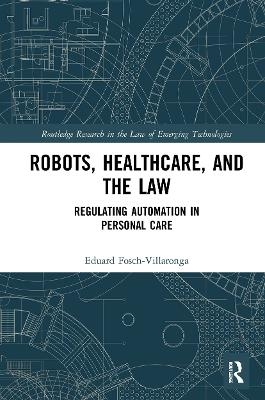
Robots, Healthcare, and the Law
Regulating Automation in Personal Care
Seiten
2021
Routledge (Verlag)
978-1-032-23980-4 (ISBN)
Routledge (Verlag)
978-1-032-23980-4 (ISBN)
The integration of robotic and artificial intelligent systems in healthcare settings is accelerating.
The integration of robotic systems and artificial intelligence into healthcare settings is accelerating. As these technological developments interact socially with children, the elderly, or the disabled, they may raise concerns besides mere physical safety; concerns that include data protection, inappropriate use of emotions, invasion of privacy, autonomy suppression, decrease in human interaction, and cognitive safety. Given the novelty of these technologies and the uncertainties surrounding the impact of care automation, it is unclear how the law should respond.
This book investigates the legal and regulatory implications of the growing use of personal care robots for healthcare purposes. It explores the interplay between various aspects of the law, including safety, data protection, responsibility, transparency, autonomy, and dignity; and it examines different robotic and AI systems, such as social therapy robots, physical assistant robots for rehabilitation, and wheeled passenger carriers. Highlighting specific problems and challenges in regulating complex cyber-physical systems in concrete healthcare applications, it critically assesses the adequacy of current industry standards and emerging regulatory initiatives for robots and AI. After analyzing the potential legal and ethical issues associated with personal care robots, it concludes that the primarily principle-based approach of recent law and robotics studies is too abstract to be as effective as required by the personal care context. Instead, it recommends bridging the gap between general legal principles and their applicability in concrete robotic and AI technologies with a risk-based approach using impact assessments.
As the first book to compile both legal and regulatory aspects of personal care robots, this book will be a valuable addition to the literature on robotics, artificial intelligence, human–robot interaction, law, and philosophy of technology.
The integration of robotic systems and artificial intelligence into healthcare settings is accelerating. As these technological developments interact socially with children, the elderly, or the disabled, they may raise concerns besides mere physical safety; concerns that include data protection, inappropriate use of emotions, invasion of privacy, autonomy suppression, decrease in human interaction, and cognitive safety. Given the novelty of these technologies and the uncertainties surrounding the impact of care automation, it is unclear how the law should respond.
This book investigates the legal and regulatory implications of the growing use of personal care robots for healthcare purposes. It explores the interplay between various aspects of the law, including safety, data protection, responsibility, transparency, autonomy, and dignity; and it examines different robotic and AI systems, such as social therapy robots, physical assistant robots for rehabilitation, and wheeled passenger carriers. Highlighting specific problems and challenges in regulating complex cyber-physical systems in concrete healthcare applications, it critically assesses the adequacy of current industry standards and emerging regulatory initiatives for robots and AI. After analyzing the potential legal and ethical issues associated with personal care robots, it concludes that the primarily principle-based approach of recent law and robotics studies is too abstract to be as effective as required by the personal care context. Instead, it recommends bridging the gap between general legal principles and their applicability in concrete robotic and AI technologies with a risk-based approach using impact assessments.
As the first book to compile both legal and regulatory aspects of personal care robots, this book will be a valuable addition to the literature on robotics, artificial intelligence, human–robot interaction, law, and philosophy of technology.
Eduard Fosch-Villaronga, Ph.D., LL.M., M.A., LL.B., is currently Marie Sklodowska-Curie Postdoctoral Researcher at the eLaw Center for Law and Digital Technologies at Leiden University in The Netherlands.
List of figures
List of tables
Acknowledgments
First foreword
Second foreword
Introduction
1 From forced labour to robots
2 Automation in healthcare
3 Robot Impact Assessment
4 Personal care robots: context and robot type
5 Robot and AI legal framework
6 Comprehensive safety
7 Consumer robotics
8 Responsibility, liability, and accountability
9 Privacy and data protection
10 Dignity and broader impacts
Conclusions
Reflections
Appendix: conducting a Robot Impact Assessment
Index
| Erscheinungsdatum | 14.12.2021 |
|---|---|
| Reihe/Serie | Routledge Research in the Law of Emerging Technologies |
| Zusatzinfo | 16 Illustrations, black and white |
| Verlagsort | London |
| Sprache | englisch |
| Maße | 156 x 234 mm |
| Gewicht | 390 g |
| Themenwelt | Informatik ► Theorie / Studium ► Künstliche Intelligenz / Robotik |
| Recht / Steuern ► Privatrecht / Bürgerliches Recht ► IT-Recht | |
| ISBN-10 | 1-032-23980-8 / 1032239808 |
| ISBN-13 | 978-1-032-23980-4 / 9781032239804 |
| Zustand | Neuware |
| Haben Sie eine Frage zum Produkt? |
Mehr entdecken
aus dem Bereich
aus dem Bereich
Buch | Softcover (2024)
REDLINE (Verlag)
20,00 €
Eine kurze Geschichte der Informationsnetzwerke von der Steinzeit bis …
Buch | Hardcover (2024)
Penguin (Verlag)
28,00 €


